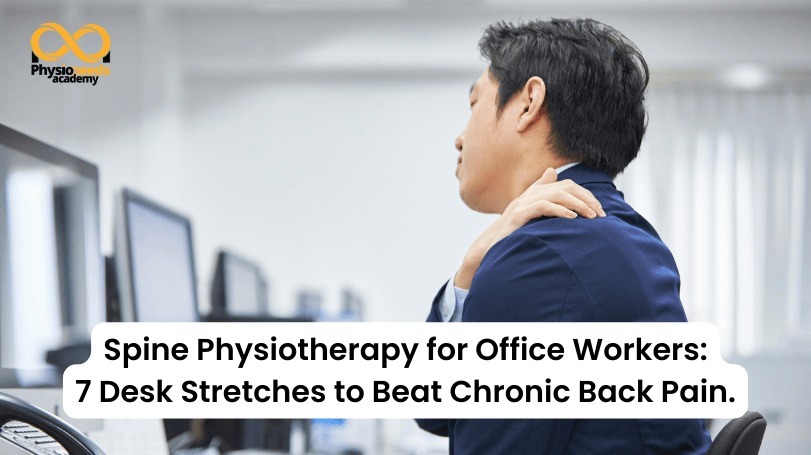There are no items in your cart
Add More
Add More
| Item Details | Price | ||
|---|---|---|---|

Spine Physiotherapy for Office Workers: 7 Desk Stretches to Beat Chronic Back Pain is important today because many people sit for long hours at work. Sitting for too long makes the back stiff and tight, and this often leads to constant pain and discomfort. Simple daily stretches can relax the muscles, improve posture, and stop long-term spine problems. Learning through a spine physiotherapy course or programs like spinal physiotherapy for physiotherapists also helps people understand how to care for their spine in an easy and practical way.
Office workers usually want quick, simple solutions that fit into their busy day. They do not want complicated exercises or confusing instructions. This is why easy desk stretches, along with basic knowledge from spinal rehabilitation for performance enhancement, can make a big difference. These methods help keep the spine healthy, reduce pain during work hours, and prevent future injuries.
When you sit for long periods, your spine faces continuous pressure. Muscles around the lower back, mid-back, and neck become weak or tight. Over time, this leads to stiffness, uneven posture, and long-lasting pain.
Physiotherapists often recommend strengthening and mobility routines to break this cycle. For professionals who want deeper knowledge, an advanced spine physiotherapy course online provides a clear understanding of how the spine responds to stress and how simple movement can correct these issues.
Below are seven simple, safe, and effective stretches you can do even during work hours. Each stretch is chosen to improve mobility, reduce tension, and keep your spine healthy.

Tilt your head gently toward one shoulder and hold. This releases tight neck muscles caused by looking down at screens.

Roll your shoulders forward and backward to loosen upper-back tension created by slouching.

Hold the back of your chair and rotate gently. This improves mobility in the mid-back and reduces stiffness.

Interlace your fingers behind your back and lift slightly. This opens your chest and corrects rounded shoulders.

Place your hands together and stretch forward. This targets the tight muscles between your shoulder blades.

Scoot to the edge of your chair and extend one leg back. This reduces pressure on the lower spine.

Extend one leg forward and reach gently. Tight hamstrings often increase lower-back pressure, so this stretch helps balance the spine.
Simple stretches can help, but long-term relief comes from understanding how your body works. This is why many physiotherapists and fitness professionals choose to study topics like spinal physiotherapy for physiotherapists or spinal rehabilitation for performance enhancement. These courses offer clear explanations, practical techniques, and structured learning that help people manage spine issues with confidence.
If someone wants flexible learning, an advanced spine physiotherapy course online is a convenient option. It teaches posture correction, mobility training, strengthening basics, and safe exercise progressions.
In the middle of every spine-care discussion, it is important to remember the central idea of Spine Physiotherapy for Office Workers: 7 Desk Stretches to Beat Chronic Back Pain, because simply adding these stretches to your routine can prevent stress from building up and improve your comfort while working.
Using these stretches has several long-lasting benefits:
· Better posture during long work hours
· Reduced stiffness in the neck, shoulders, and lower back
· Improved blood flow, which keeps muscles relaxed
· Less fatigue and better focus during the day
· Lower risk of developing chronic spine conditions
· Increased confidence in your movement
When combined with proper training through a spine physiotherapy course, these habits support your spine through work, exercise, and daily movement.
A large number of office workers now experience pain early in their careers. Many are young professionals who want fast, clear, and effective solutions. Courses like spinal rehabilitation for performance enhancement and spinal physiotherapy for physiotherapists offer practical guidance that helps people understand how to improve movement quality and prevent pain.
These programs teach:
· How posture affects spine health
· Why muscles become tight or weak
· How to choose the right exercises
· How to design a simple routine for daily relief
· When to progress or modify movements
An advanced spine physiotherapy course online also helps learners who cannot attend in person. It is easy to follow, flexible, and designed for real-world use.
Today’s office workers make up one of the largest job groups in the world. They sit for more than 8–10 hours a day, often without structured breaks. This demographic is actively searching for number-based, practical solutions they can use right away. They want simple stretches, proven techniques, and courses that teach useful skills in an easy format.
That is what makes this topic so valuable—and why applying the ideas behind Spine Physiotherapy for Office Workers: 7 Desk Stretches to Beat Chronic Back Pain is one of the best ways to improve long-term spinal health.